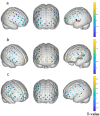Real-time changes in brain activity during sacral neuromodulation for overactive bladder: evidence from functional near-infrared spectroscopy
- PMID: 40356704
- PMCID: PMC12066680
- DOI: 10.3389/fnins.2025.1436172
Real-time changes in brain activity during sacral neuromodulation for overactive bladder: evidence from functional near-infrared spectroscopy
Abstract
Objective: The mechanisms underlying overactive bladder (OAB) and the role of sacral neuromodulation (SNM) in its treatment are not fully understood. In this study, functional near-infrared spectroscopy (fNIRS) was used to identify changes in brain activity during SNM in patients with OAB who responded to therapy.
Methods: We employed a prospective trial method and idiopathic OAB patients selected for SNM treatment at our center were assigned to the experimental group and healthy adults matched by gender and age constituted the healthy control (HC) group. All participants completed 72-h urination diaries, the Overactive Bladder Symptom Score (OABSS), functional near-infrared spectroscopy (fNIRS) scans in both resting and task states, along with synchronous urodynamic monitoring. OAB patients were re-evaluated for these indicators after the SNM electrode implantation phase I test. The MATLAB toolbox NIRS-KIT was used to analyze and compare the differences in the internal functional connectivity (FC) of the prefrontal cortex (PFC) between the OAB group and the HC group before and after the treatment, in addition to assessing the differences in the PFC cortical activation/inactivation regions of the brain.
Results: 1. A total of 10 HCs and 12 patients with OAB were included. After the SNM Phase I test, 10 patients with OAB were successful, while 2 patients failed. The average frequency of 24-h urination, the levels of urgency and incontinence, and OABSS in the OAB group were significantly higher than those in the HC group. After the SNM treatment, the parameters recorded in urination diaries, OABSS, and urodynamic measures in the successful OAB group were significantly improved compared to their levels before treatment. 2. Task fNIRS results: Compared to the HC group, BA9 (left dorsolateral prefrontal lobe) was significantly inactivated in the successful OAB group before SNM treatment. Compared to the HC group, there was no significant difference in brain activation after SNM treatment in the successful OAB group. BA9 (left dorsolateral prefrontal lobe) and BA45 (the triangular part of the left inferior frontal gyrus) were significantly activated after the SNM treatment in the successful OAB group in contrast to their activation levels before treatment. 3. Resting fNIRS results: Compared to the HC group, the FC of the PFC in the successful OAB group was significantly weakened in both the empty and filled bladder states before SNM treatment; however, after SNM treatment, it returned to normal. Compared to the HC group, there was no significant difference in the FC of OAB patients in the empty bladder state after treatment, but the FC was significantly activated during the strong desire to void state.
Conclusion: We found abnormal deactivation of the FC in the PFC and left dorsolateral prefrontal lobe (BA9), which might lead to socially inappropriate involuntary urination and could be a central pathogenesis of OAB. SNM restored the functional connectivity in the left dorsolateral frontal lobe, the triangular part of the left inferior frontal gyrus, and the interior of the prefrontal lobe in patients with OAB, which may be one of the central mechanisms of SNM treatment for OAB. Our results may provide valuable insights into the central pathogenesis of OAB and the central mechanism of SNM treatment.
Keywords: fNIRS (functional near infrared spectroscopy); overactive bladder; sacral neuromodulation; sacral neuromodulation (SNM); urodynamics.
Copyright © 2025 Luo and Liao.
Conflict of interest statement
The authors declare that the research was conducted in the absence of any commercial or financial relationships that could be construed as a potential conflict of interest.
Figures






Similar articles
-
Sacral Neuromodulation Improves Abnormal Prefrontal Brain Activity in Patients with Overactive Bladder: A Possible Central Mechanism.J Urol. 2022 Jun;207(6):1256-1267. doi: 10.1097/JU.0000000000002445. Epub 2022 Jan 24. J Urol. 2022. PMID: 35072489
-
Pattern of prefrontal cortical activation and network revealed by task-based and resting-state fNIRS in Parkinson's disease's patients with overactive bladder symptoms.Front Neurosci. 2023 Mar 30;17:1142741. doi: 10.3389/fnins.2023.1142741. eCollection 2023. Front Neurosci. 2023. PMID: 37065919 Free PMC article.
-
Real-time changes in brain activity during tibial nerve stimulation for overactive bladder: Evidence from functional near-infrared spectroscopy hype scanning.Front Neurosci. 2023 Apr 5;17:1115433. doi: 10.3389/fnins.2023.1115433. eCollection 2023. Front Neurosci. 2023. PMID: 37090808 Free PMC article.
-
What uro-gynecologists should know about sacral neuromodulation (SNM) for the treatment of refractory overactive bladder.Arch Gynecol Obstet. 2019 May;299(5):1243-1252. doi: 10.1007/s00404-019-05127-7. Epub 2019 Apr 2. Arch Gynecol Obstet. 2019. PMID: 30941558 Review.
-
Sacral neuromodulation for female pelvic floor disorders.Arab J Urol. 2019 Apr 18;17(1):14-22. doi: 10.1080/2090598X.2019.1589930. eCollection 2019 Mar. Arab J Urol. 2019. PMID: 31258941 Free PMC article. Review.
References
-
- Abrams P., Cardozo L., Fall M., Griffiths D., Rosier P., Ulmsten U., et al. . (2003). The standardisation of terminology in lower urinary tract function: report from the standardisation sub-committee of the international continence society. Urology 61, 37–49. doi: 10.1016/s0090-4295(02)02243-4, PMID: - DOI - PubMed
LinkOut - more resources
Full Text Sources
Miscellaneous

